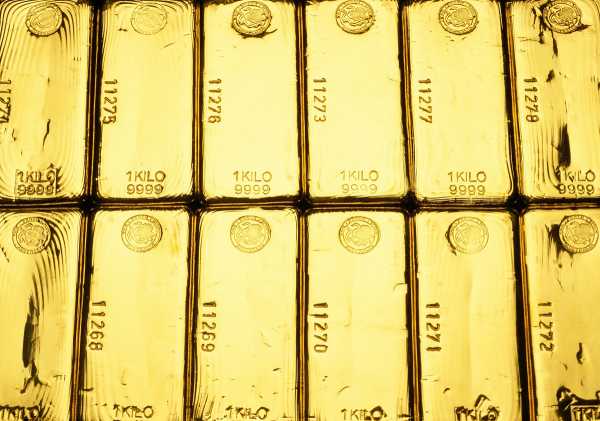The recent uptick in gold prices may face resistance at the $2000 milestone, while a dip below $1900 could lead to a decline towards the $1800 range, as gold's volatility is intertwined with the fluctuations of the US dollar and is influenced by interest rates.
Gold and silver prices rise as the weaker U.S. dollar index and dip in U.S. Treasury yields attract futures traders and bargain hunters, while anxieties build over upcoming speeches from the Fed and ECB on future monetary policy direction and the potential shift in the Fed's inflation goal.
Gold prices are slightly up and silver prices have hit a three-week high due to short covering and bargain hunting, with silver seeing significant improvement in its technical posture.
The gold market is in need of a catalyst to break its current downtrend, with the upcoming economic data playing a crucial role in determining its direction.
Bitcoin's 200-week EMA at around $25,700 is a crucial support level to watch, and if it holds, it could signal a potential entry point for a reversal, according to BTC price analysis.
Gold price is aiming to sustain above $1,920.00 as pressure builds on the US Dollar and Treasury yields, with the upcoming labor market data playing a crucial role in guiding the Federal Reserve's policy action.
Renewed physical demand from emerging markets, such as India and China, could reignite the gold market's bullish uptrend and drive prices higher towards $2,000 an ounce before the end of the year, according to market strategist George Milling-Stanley.
The improving economic outlook for the US has made gold less appealing to investors, but weakness in US consumers could still lead to a recession and boost the precious metal, while Chinese stimulus may support silver demand, according to Heraeus' precious metals report.
Gold reaches its highest point in nearly a month due to weak U.S. economic readings, suggesting that the Federal Reserve may halt its interest rate hikes.
Gold prices could receive a boost from key technical indicators, U.S.-China tensions, and weaker economic data, despite some challenges, according to Arslan Butt, Lead Commodities and Indices Analyst at FX Leaders.
The gold market remains steady despite stable inflation pressures, suggesting that the US central bank may be able to end its tightening cycle.
Gold futures have seen two consecutive weeks of gains and have formed a bullish reversal pattern known as a piercing line, suggesting that gold could potentially reach or exceed $2000 per ounce in the near future.
Gold prices rose slightly last week while silver remained mostly unchanged, but both metals are expected to potentially move together in an upward direction next week due to a dovish outlook on interest rates and potential repricing of the Federal Reserve's monetary policy.
Gold prices decline slightly as the dollar remains strong, with investors awaiting further signals on the U.S. Federal Reserve's monetary policy after an expected interest rate pause this month.
Gold could retest $1900 before experiencing further gains, due to seasonal factors, the strength of stocks and the US dollar, according to Sean Lusk, co-director of commercial hedging at Walsh Trading, but he remains optimistic about the longer-term outlook for the precious metal.
The U.S. dollar's dominance in the gold market may be losing momentum, potentially leading to new all-time highs for gold as the dollar weakens, according to market strategist Carley Garner. She expects the U.S. dollar index to hold resistance below 105 points and eventually retest support at 99 points, which could be a game changer for gold, potentially pushing prices to $2,600 an ounce. Garner also highlights the resilience of gold and the potential for a selloff if the Federal Reserve shifts to a more neutral monetary policy stance. However, she is not as optimistic about silver, preferring to focus on gold.
The dollar index has been on a sustained rally since mid-July, leading to a slight decline in gold prices due to the inverse relationship between the two, but gold has held up well despite the strength of the dollar.
Gold prices are slightly higher and silver prices are steady in early U.S. trading due to mild short covering and bargain hunting, with traders awaiting the consumer price index report for August.
The Bank of England's rapid pace of bond sales is causing concern among investors and creating a "selling gold at the bottom" moment, as the central bank unwinds its holdings and faces massive losses, while pushing down gilt prices and worsening losses for taxpayers. The pace of the sales is faster than that of other central banks and is reminiscent of the controversial gold disposal in the early 2000s, leading some to believe it could mark the bottom of the market, presenting an investment opportunity.
Gold gained as the dollar weakened against the yuan due to positive China economic data, although the possibility of further U.S. interest rate hikes kept investors cautious.
Gold prices rose 1% on Friday due to a weaker dollar and increased safe-haven buying following strikes at three automakers in Detroit, while expectations of a pause in U.S. interest-rate hikes further supported the precious metal.
The gold market is testing resistance around $1,950 an ounce as U.S. sentiment sours and inflation pressures ease.
Gold prices rose as the dollar weakened and investors awaited central bank policy meetings, with the Fed expected to pause on interest rate hikes.
